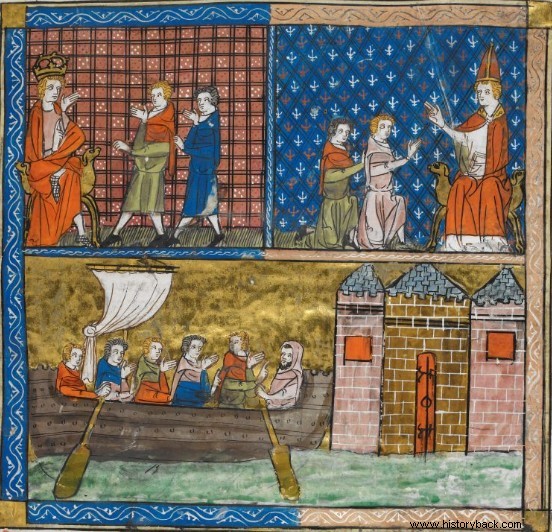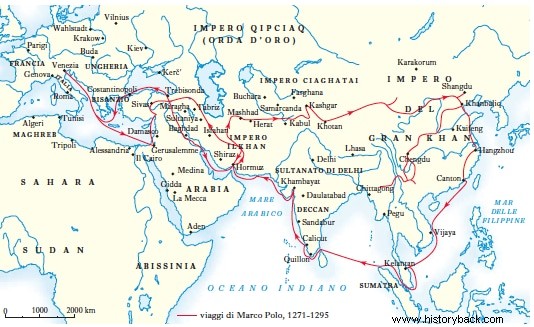In Iran Marco Polo is a way of saying.
In Farsi, the local language, marcopolò , all attached with an accent on the final vowel, still indicates today someone who travels a lot, and therefore it is time for him to go home.
The Venetian traveler stayed for more than 24 years overall. , from 1271 to 1295 .
The book collects all the knowledge of the Asian world of the 13th century (we could consider it a sort of vademecum of the medieval East).
None of the sixty-four globes dated from the seventh to the end of the thirteenth century gives any idea of what the vast regions extending eastwards to the beyond the Ganges, the Himalayas, the Pamirs and the Urals ». In the majority of cases we limited ourselves to leaving empty spaces, in others there are not very reassuring writings such as "Hinc abundant leones or Antropophagi", as if to justify this ignorance by bringing up dangerous animals or peoples at the last stage of evolution.

The importance of The Million it was fundamental for Western history, especially for the compilation of the Map of Fra Mauro :it is also believed that the book of the Venetian merchant inspired the travels of Christopher Columbus (which then led to the discovery of the Americas ).

The Million it is not a travel diary but an account of what we saw and heard during the journey, almost entirely devoid of details on the movements,
The work is divided into 183 chapters according to the Magliabechiano code . The original title is very different from what we know today:it was in fact translated from the French Le livre de Marco Polo citoyen de Venise , say Million , où l'on conte les merveilles du monde (The book of Marco Polo citizen of Venice , called Million , where the wonders of the world are told).
The title we know today derives from a distortion of the nickname of the Polo Family :“ Emilione ".
There are more than 150 translations de The Million , including French, Latin and the Venetian dialect, although the most important, which is presumed to be the original one, is the one written in the oil language.

The famous book was written by Rustichello da Pisa , under the dictation of the Venetian traveler during their common imprisonment.
On his travels to and from China , ancient Persia was the country where the Venetian merchant stayed the longest, passing through twice:between 1272 and 1273 , at the beginning of his journey in the company of his father Niccolò and uncle Matteo ; and on the way back to Venice, between 1293 and 1294 , after seventeen years of residence at the court of Kublai Khan and two years of sea voyage to lead Princess Kokacin to her betrothed in Persia.
Her journey through Asia lasted three and a half years .
The Silk Road passed by here. The network of caravan routes - which connected Mediterranean and East - cut the Persian territory longitudinally, touching Ecbatana (current Hamadan ) and Mashad , before moving on to Afghanistan ; with a variant, for those coming from the sea, which comes from Hormuz , in the Persian Gulf , went up the central Iranian plateau up to Tabriz, on the threshold of Turkey .

The Mongol invasion of the Islamic world began in 1221 and it was consolidated in 1258 with the conquest of Baghdad . The eight realms that made up Persia cited by Marco (including cities with the same names, such as Isfahan , Shiraz and Qazvin ) were placed "under the dominion of the Tatar king of the East".
The ancient civilization was subdued, but the relative political unity of the territories conquered by the Mongols had made those lands more peaceful despite the rivalries between the khan . It had become easier for merchants and religious to travel. Especially if they are gifted - like the Polos - gold plates (paiza), "tables of command" of the Great Khan , a sort of pass within Tartaria .
If the geography described in the Million it hasn't changed, many other things are. Marco he speaks of houses and "tall and superb mud walls". Some portions of old cities survive intact:as in Yazd , the Jasdi of the Million , on the edge of the Dasht desert -and Kavir and that of the Dasht - and Lut , "Very beautiful and large city" and "of many merchandise", for Unesco one of the oldest inhabited centers in the world, certainly the oldest in Persia, with the Towers of the Wind ( badgir , built to capture every breath of air and channel it inside the houses) that still stand out on the roofs. The walls of the fortress-city of Bam instead, spectacular scenes of the film The desert of the Tartars that Valerio Zurlini drew from the novel of the same name by Buzzati , no longer exist, destroyed by the earthquake of 2003 .
Crossing Persia , Marco it only touches the traces of past glory, unavoidable stops on today's tours. He does not mention the splendor of the columns and decorations of the Royal Palace of Persepolis , which half buried in the sand remain outside his itinerary. On several occasions, however, he crosses the passage of another Westerner, Alexander the Great , who came here in 330 BC to defeat those who had dared to push the borders of their empire to the threshold of Greece , like when it passes by the Alone Tree, at the northern borders of Persia , where it is assumed that the clash between the armies of Alexander and Dario took place . To Yazd you can see the “ Alexander's Prison “, Well that Macedonians are said to use as a cell; in Pasargade stands the tomb of Ciro the Great , that Alessandro he found it in a state of decay and had it restored.
Marco has a practical spirit, describes a country of traders and artisans, records the great abundance of exotic fruits, cotton, wheat, barley, millet, notes the type of material things:goods and products, from horses to donkeys, from gold to silk . To Yazd the iassi mentioned by Marco is still produced ("Gold and silk drapes that are worn for many districts"). In all bazaars, from Tabriz in Tehran , from Shiraz to Isfahan , there is always a large section of shops selling gold, silver and precious stones. The shop windows are overflowing with bracelets and rings. Gold, above all, which continues to exercise its double function:ornamental, in family gatherings, non-mourning ceremonies, in parties; and economic, a form of saving and investment with a stable value.
But the Venetian merchant-traveler is also gifted with curiosity and thirst for knowledge. From eyewitness to narrator, with the help of Rustichello da Pisa , of a world almost unknown in the eyes of the West. He observes, listens, experiences, collects stories. Like the new oriental version of the legend of the three Magi , kings gone to visit Jesus just born, from a Persian city called Saba (now Saveh). They were probably Zoroastrian priests, the dominant religion in the Iranian plateau before the Arab conquest.
To Yazd the largest community among the Iranian devotees of Zoroaster lives . A modern building houses the temple of Ateshkadeh (Eternal Sacred Fire) where a fire is kept which, it seems, has been burning without interruption since 470 AD About fifteen km south of the city rise the Towers of Silence , platforms where the Zoroastrians, up to fifty years ago, left the corpses to the vultures so as not to contaminate the earth and air. A platform on the highest hill, for men; a smaller one, for women and children; at the base of water tanks, Towers of the Wind , houses of priests.
Today the Towers of Silence , solemn, solitary, they are a destination for walks and pilgrimages. There are other Zoroastrian sites around Yazd, the most important being the Chak Chak Fire Temple , 70 km from the city, which attracts pilgrims especially in mid-June, when Zoroastrians from all over the world gather for their annual festival. The heart is the cave where, according to tradition, a princess who took refuge in these mountains to escape the Arab invasion found a source of water that filtered a drop ( chak ) drop ( chak ) from the rock. In the center, a brazier welcomes the sacred fire and votive candles, all around dozens of containers are used to collect and then drink the water that drips from the rock. In the Mongol Empire, prone to syncretism and the coexistence of beliefs, Marco crosses many religious variants.
In Persia tells of those who “ adore Malcometto “, The Muslims - whom he calls all Saracens (from the Arabic sarqi , Eastern) - towards whom, as a son of the Europe of the Crusades, he is rather hasty, perceiving them as antagonists. Impregnated with the prejudices widespread among the Christians of the time, Marco it also tells of the “sect of the murderers of the Old Man of the Mountain ", Founded in the eleventh century. by the grand master Hassan Sabbah . "Saracen heretics" of the Shiite family of Ismaili, known for the ferocious determination with which they acted against political oppressors and religious enemies that legend has it derived from the intake of hashish ("drink of sleep" alluded to in the Million), for this reason like hashishin, "killers". The fedayn del Vecchio raged until the middle of the 13th century. when their stronghold, the castle of Alamut , was conquered by the Mongols .
Today the village at the foot of the cliff on which the castle stood takes its name from the leader who put an end to the reign of the Old Man of the Mountain , Gazorkhan ; the ruins are being restored; rice fields, fields of wheat and cotton have taken the place of the gardens evoked by Marco that once surrounded the castle. On the edge of the road that cuts through the mountain before flowing into the valley irrigated by the river , settlements of beekeepers still produce the honey that Marco already mentioned together with the "rivers of wine, milk and pure water" and the "beautiful women" that the Old Man offered to his men.
